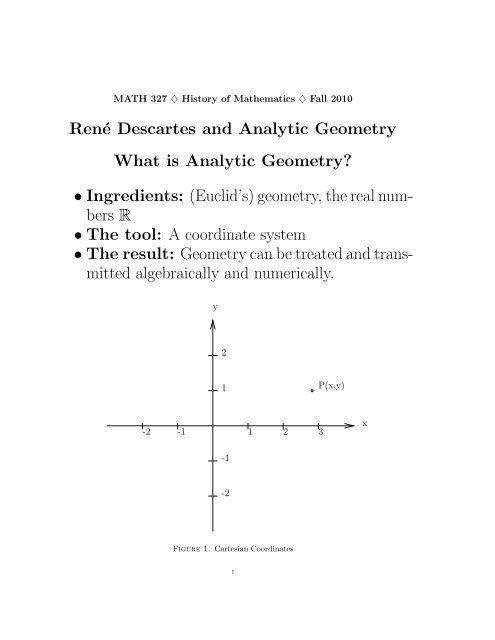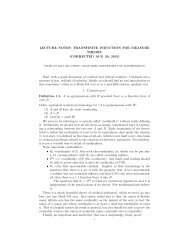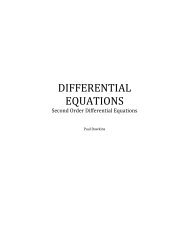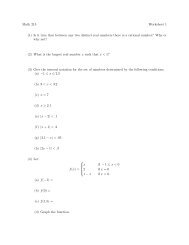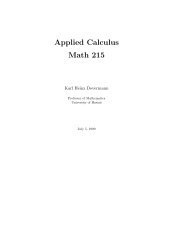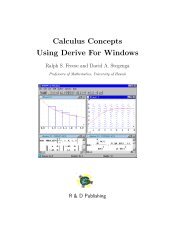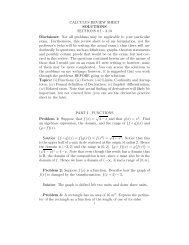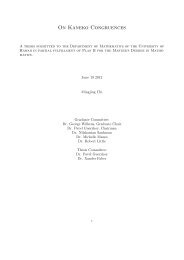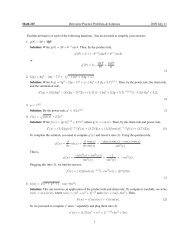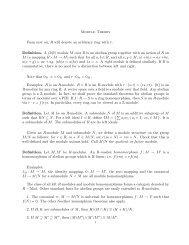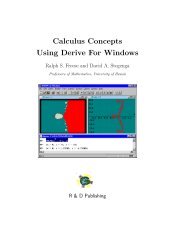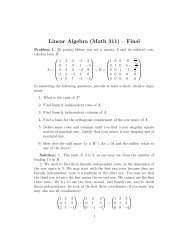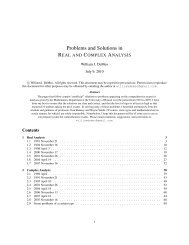René Descartes and Analytic Geometry What is ... - Technion moodle
René Descartes and Analytic Geometry What is ... - Technion moodle
René Descartes and Analytic Geometry What is ... - Technion moodle
You also want an ePaper? Increase the reach of your titles
YUMPU automatically turns print PDFs into web optimized ePapers that Google loves.
MATH 327 ♦ H<strong>is</strong>tory of Mathematics ♦ Fall 2010<br />
<strong>René</strong> <strong>Descartes</strong> <strong>and</strong> <strong>Analytic</strong> <strong>Geometry</strong><br />
<strong>What</strong> <strong>is</strong> <strong>Analytic</strong> <strong>Geometry</strong>?<br />
• Ingredients: (Euclid’s) geometry, the real numbers<br />
R<br />
• The tool: A coordinate system<br />
• The result: <strong>Geometry</strong> can be treated <strong>and</strong> transmitted<br />
algebraically <strong>and</strong> numerically.<br />
-2<br />
-1<br />
y<br />
2<br />
1<br />
-1<br />
-2<br />
1 2 3<br />
Figure 1. Cartesian Coordinates<br />
1<br />
P(x,y)<br />
x
2<br />
P<br />
<strong>Geometry</strong> <strong>Analytic</strong> <strong>Geometry</strong> Name<br />
Q<br />
(x, y) point<br />
Ax + By + C = 0 straight line<br />
(x − h) 2 + (y − k) 2 = r 2 circle, center (h, k), radius r<br />
<br />
(x2 − x1) 2 + (y2 − y1) 2 d<strong>is</strong>tance P to Q<br />
m = y2−y1<br />
x2−x1<br />
Figure 2. Translation table<br />
slope, inclination versus x-ax<strong>is</strong>
• Many problems of geometry can be solved by<br />
working with lengths of line segments.<br />
• Call the unknown line segments x,y, z, ... <strong>and</strong><br />
the given line segments a,b,c,..., find relations<br />
between them by computing the same quantity<br />
in two ways. Solve the equations.<br />
3
4<br />
In what sense does Ax + By + C = 0<br />
describe a straight line?<br />
Example. A point (a,b) <strong>is</strong> on the straight line ℓ<br />
given by 3x−5y+3 = 0 if <strong>and</strong> only if 3a−5b+3 = 0,<br />
i.e.,<br />
ℓ = {(x, y) | 3x − 5y + 3 = 0}<br />
Example. A point (a,b) <strong>is</strong> on the circle C given by<br />
(x − 5) 2 + (y + 3) 2 = 25 if <strong>and</strong> only if (a − 5) 2 + (b +<br />
3) 2 = 25, i.e.,<br />
C = {(x, y) | (x − 5) 2 + (y + 3) 2 = 25}
<strong>René</strong> <strong>Descartes</strong> (1596-1650)<br />
• Lesser nobility, but inheritence from mother rendered<br />
<strong>Descartes</strong> financially independent.<br />
• Educated at a Jesuit college entering at the age<br />
of eight years, leaving at age 16.<br />
• Being in poor health he was granted perm<strong>is</strong>sion<br />
to remain in bed until 11 o’clock in the morning,<br />
a custom he maintained until the year of h<strong>is</strong><br />
death.<br />
• Law degree from Poitiers in 1616.<br />
• Enl<strong>is</strong>ted as gentlemen soldier. After two years<br />
in Holl<strong>and</strong> he travelled through all of Europe.<br />
In a hot room revelation of “the foundation of a<br />
marvellous science” <strong>and</strong> calling to pursue it.<br />
• Settled down in Holl<strong>and</strong>.<br />
• First major treat<strong>is</strong>e on physics, Le Monde, ou<br />
Traité de la Lumière. News that Galileo Galilei<br />
was condemned to house arrest. Decided not to<br />
r<strong>is</strong>k publication. World starts with original vortices<br />
<strong>and</strong> develops according to laws of mechanics.<br />
5
6<br />
• Wrote D<strong>is</strong>cours de la méthode pour bien<br />
conduire sa ra<strong>is</strong>on et chercher la vérité<br />
dans les sciences. Three appendices were La<br />
Dioptrique, Les Météores, <strong>and</strong> La Géométrie. He<br />
popularizes the analytic approach to geometry.<br />
• In 1649 Queen Chr<strong>is</strong>tina of Sweden persuaded<br />
<strong>Descartes</strong> to come to Stockholm as her personal<br />
tutor. The Queen worked early in the morning.<br />
After only a few months in the cold northern<br />
climate, <strong>Descartes</strong> died of pneumonia.<br />
• <strong>Descartes</strong> constitutes “the turning point between<br />
medieval <strong>and</strong> modern mathematics”.
D<strong>is</strong>cours de la Méthode (D<strong>is</strong>cussion of Method)<br />
• Clear influence of Euclid: looking for basic principles,<br />
logical deduction.<br />
• Doubt! D<strong>is</strong>regard acquired knowledge, start from<br />
the beginning.<br />
• “I think therefore I am”.<br />
• God ex<strong>is</strong>ts because there must be perfection.<br />
• Search for basic principles <strong>and</strong> derive (explain)<br />
phenomena.<br />
• Verify the truth of the basic principles by experimentally<br />
checking the consequences.<br />
7
8<br />
From D<strong>is</strong>cours de la Méthode<br />
I thought the following four [rules] would be enough,<br />
provided that I made a firm <strong>and</strong> constant resolution<br />
not to fail even once in the observance of them.<br />
• Never accept anything as true if there<br />
<strong>is</strong> not evident knowledge of its being so,<br />
that <strong>is</strong>, carefully avoid precipitancy <strong>and</strong><br />
prejudice;<br />
• Divide each problem into as many parts<br />
as <strong>is</strong> feasible, <strong>and</strong> as <strong>is</strong> requ<strong>is</strong>ite for its<br />
better solution;<br />
• Direct your thoughts in an orderly way;<br />
beginning with the simplest objects, those<br />
most apt to be known, <strong>and</strong> ascending<br />
little by little, in steps as it were, to<br />
the knowledge of the most complex;<br />
• to make throughout such complete enumerations<br />
<strong>and</strong> such general surveys that<br />
might make sure of leaving nothing out.
These long chains of perfectly simple <strong>and</strong> easy reasonings<br />
by means of which geometers are accustomed<br />
to carry out their most difficult demonstrations had<br />
led me to fancy that everything that can fall under<br />
human knowledge forms a similar sequence.<br />
It <strong>is</strong> not enough to have a good mind. The<br />
main thing <strong>is</strong> to use it well.<br />
If you would be a real seeker after truth,<br />
you must at least once in your life doubt,<br />
as far as possible, all things.<br />
9
10<br />
Optics<br />
<strong>Descartes</strong> explains refraction, reflection, function of<br />
the eye, lenses, how to construct lenses.<br />
Meterology<br />
<strong>Descartes</strong> explains the rainbow, develops a theory of<br />
the weather.<br />
“Despite its many faults, the subject of meteorology<br />
was set on course after publication of Les Météores<br />
particularly through the work of Boyle, Hooke <strong>and</strong><br />
Halley.”
On geometry<br />
• Replace the geometric algebra of the Greeks by<br />
numerical algebra. Think of line segments as<br />
numbers. Then, e.g., a 2 + b makes sense.<br />
See pages 177 <strong>and</strong> 178.<br />
11
12<br />
• Pappus: Appolonius says that the problem of<br />
the locus related to three or four lines was not<br />
entirely solved by Euclid, <strong>and</strong> that neither he<br />
himself or anyone else was able to solve it completely.<br />
<strong>Descartes</strong> solved th<strong>is</strong> 1850 year old problem.<br />
See pages 183, 184
• The Problem: Given straight lines a1,a2,...<br />
<strong>and</strong> angles α1, α2,.... Given a point P, let d1,d2,...<br />
be the lengths of the line segments PQi where<br />
Qi <strong>is</strong> on ai <strong>and</strong> PQi makes the angle αi with ai.<br />
Find the locus of all points P such that certain<br />
products of the di have a given ratio with the<br />
product of the rest of the di.<br />
13
14<br />
Observations.<br />
(1) Without loss of generality di = d<strong>is</strong>t(P,ai) because<br />
d ′ = d sin(α).<br />
P<br />
d ′<br />
d<br />
α
(1) In a Cartesian coordinate system the d<strong>is</strong>tance of<br />
a point P = P(x, y) from a line a : Ax + By +<br />
C = 0 <strong>is</strong> given by the formula<br />
d<strong>is</strong>t(P,a) = |Ax+By+C|<br />
√ A 2 +B 2 .<br />
15
16<br />
(1) Solutions:<br />
a1<br />
d2<br />
P<br />
d3<br />
a2<br />
d1<br />
a3<br />
d1 · d2 = d3 or d1 · d2 = d 2 1<br />
Figure 3. A problem of Appolonius <strong>and</strong> Pappus<br />
(a) Two lines:<br />
|A1x + B1y + C1| = f|A2x + B2y + C2|, f ∈ R.<br />
The locus <strong>is</strong> a pair of straight lines.<br />
(b) Three lines:<br />
|A1x+B1y+C1||A2x+B2y+C2| = f|A3x+B3y+C3|.<br />
The locus <strong>is</strong> a conic section.<br />
(c) Four lines:<br />
|A1x + B1y + C1||A2x + B2y + C2|<br />
= f|A3x + B3y + C3||A4x + B4y + C4|.<br />
The locus <strong>is</strong> a conic section.
(d) Five lines:<br />
|A1x + B1y + C1||A2x + B2y + C2| =<br />
f|A3x + B3y + C3||A4x + B4y + C4|<br />
· |A5x + B5y + C5|, f ∈ R.<br />
Here without loss of generality B5 = 0, then,<br />
given x we have a quadratic equation in y that<br />
can be solved by compass <strong>and</strong> ruler alone.<br />
(e) Six or more lines: The equations can have high<br />
degrees, out of reach of ancient geometers.<br />
Curves before <strong>Descartes</strong> See http://xahlee.org<br />
17
18<br />
(2) <strong>Descartes</strong>’ solution.<br />
a1<br />
a3<br />
F<br />
E<br />
D<br />
a2<br />
k<br />
T<br />
S<br />
A<br />
R<br />
x<br />
α3 α4<br />
d3<br />
y<br />
α2<br />
d2<br />
B<br />
C<br />
ℓ = AG<br />
Set x = AB <strong>and</strong> y = CB. Angles in the<br />
configuration are largely known.<br />
α1<br />
G<br />
d4<br />
a4
Using essentially the Law of Sines, he computes<br />
that<br />
CB = y<br />
CD = r2y + r1x<br />
CF = r4y + r3r4k + r3r4x<br />
CH = r6y + r5r6ℓ + r5r6x,<br />
where k = AB, ℓ = AG, <strong>and</strong> the ri are fractions<br />
of sines of known angles. H<strong>is</strong> conclusions: Same<br />
as above.<br />
(3) <strong>Descartes</strong> essentially created relations F(x, y) =<br />
0 <strong>and</strong> functions y = f(x).<br />
19
20<br />
General Curves<br />
• Curves can be described algebraically with respect<br />
to lines of reference.<br />
y y ′ y ′′ y ′′′<br />
x x ′ x ′′ x ′′′<br />
Figure 4. General curves according to <strong>Descartes</strong><br />
• D<strong>is</strong>plays mechan<strong>is</strong>ms that result in curves whose<br />
algebraic descriptions are more <strong>and</strong> more complicated.<br />
• Essentially explains the graph of a function f:<br />
graph of f = {(x,f(x)) | x ∈ R}.<br />
• Graphs of a relation F:<br />
graph of F = {(x, y) | F(x, y) = 0}<br />
• Develops a method for finding the tangent to a<br />
curve.
The question of dimension<br />
Figure 5<br />
(x), Ax = B, Ax 2 + Bx + C = 0<br />
(x, y), Ax + By + C = 0, Ax 2 + By 2 + C = 0<br />
(x, y, z),<br />
V<strong>is</strong>ualization fails but algebraically we can go on<br />
Ax + By + Cz + D = 0, Ax 2 + By 2 + Cz 2 + D = 0<br />
21
22<br />
• (x,y),<br />
Ax + By + C = 0,<br />
Ax 2 + By 2 + C = 0<br />
• (x,y, z),<br />
Ax + By + Cz + D = 0,<br />
Ax 2 + By 2 + Cz 2 + D = 0<br />
• (x,y, z,t),<br />
Ax + By + Cz + Dt + E = 0,<br />
Ax 2 + By 2 + Cz 2 + Dt 2 + E = 0<br />
• (x,y, z,t, u),<br />
Ax + By + Cz + Dt + Eu + F = 0,<br />
Ax 2 + By 2 + Cz 2 + Dt 2 + Eu 2 + F = 0<br />
• (x1, x2, ...,xn),<br />
A1x1 + A2x2 + · · · + Anxn + B = 0,<br />
A1x 2 1 + A2x 2 2 + · · · + Anx 2 n + B = 0


